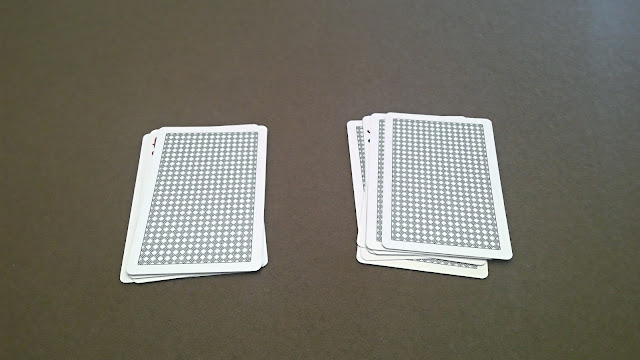When you reverse, or turn over, the short pile you now have two face-up cards in that pile matching the two face-up cards in the taller pile.
Example 2
Your audience put four face-up
cards in the pile of seven and one in the pile of five.
When you reverse, or turn over, the short pile you now have
four face-up cards in that pile matching the four face-up cards in the taller
pile. Now, you can probably see the pattern of what is happening.
Additional Examples
Try it for yourself – place any
number of the face-up cards in the tall pile and flip over the short pile to
confirm that this works for any number of the face-up cards starting in the
tall pile. It should work even if you place all five or none in the tall pile.
For advanced thinkers - How does it work?
Understanding this trick requires
some simple algebra. Let X=number of
face-up cards in the tall pile.
When your audience splits up the
cards into two piles of seven and five cards, you know that the tall pile has X
face-up cards.
In total you started with five
face-up cards, so if the tall pile has x face-up cards then the remainder (5-X)
are in the short pile. Since the short pile has 5 cards in total and 5-X are
face-up cards, then it has x number of
face-down cards. Regardless of how many of the original face-up cards are
placed in the tall pile, there will be a matching number of face-down cards in
the short pile. Simply turning over the short pile converts all its face-down
cards to be face-up so now the number of face-up cards in both piles is the
same in both piles.
The table below also shows this:
|
|
Tall Pile |
Short Pile |
Both Piles Combined |
|
Total number of cards |
7 |
5 |
12 |
|
Face-up cards |
X |
5-X |
5 |
|
Face-down cards |
7-X |
5-(5-X)=X |
7 |
|
Face-up cards after flipping over Short Pile |
X |
X |
2X |
Note:
the variable X represents the number of face-up cards in the tall pile.
Additional ways to perform the trick
Variation 1: Turn your back to
the table. Ask the audience to split the cards into the two piles of seven and
five cards. Then have them cover the piles with a large napkin. When you turn
around, place your hands under the napkin and announce that you will rearrange
the cards so both will have the same number of face-up cards. You complete the
trick simply by turning over the short pile.
Variation 2: Turn your back to
the table. Ask the audience to split the cards into the two piles of seven and
five cards. Turn around and hold your hands directly over the two piles. Of
course, you can see the top card of each pile but not the others. Announce you
“sense” the orientation of the cards underneath the top cards. After a few
seconds, turn your back to the table again. Ask your audience to exchange the
bottom two cards of each pile without changing their orientation (actually, you
can ask them to exchange any number of ways between the two piles – for example,
exchange the bottom three cards of the short pile with the top three cards of
the tall pile). Next ask them to flip the short pile over. Turn around and
confirm with your audience that the two piles now have the same number of
face-up cards.
Variation 3: Start with a
different number of cards in total. To make the “trick” work, the number of
starting face-up cards must match the size of the short pile. Use a table like
the one above to make sure the trick will work for the number of cards you
select.
Variation 4: Use coins instead of
cards. Instead of face-up and face-down, use the heads and tails side of the
coins for the trick. This works a little better using the napkin cover;
however, some audience members may suspect that you are feeling each coin to
determine their orientation.









No comments:
Post a Comment